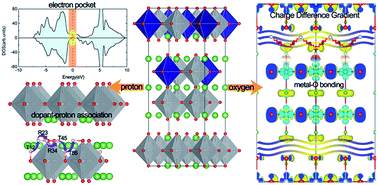Oxygen migration and proton diffusivity in transition-metal (Mn, Fe, Co, and Cu) doped Ruddlesden–Popper oxides†
Abstract
Layered Ruddlesden–Popper oxides La2NiO4/La3Ni2O7 (n = 1, 2) are considered as promising electrode candidates for electrochemical devices due to their excellent mixed ionic–electronic conducting properties. In this study, we systematically investigate both oxygen migration and proton diffusivity for transition-metal (Mn, Fe, Co and Cu) doped La2NiO4/La3Ni2O7 using first-principles calculations. The results show that the double-layered La3Ni2O7 exhibits better transport behavior than single-layered La2NiO4, which consistently corresponds to the experimental results. Transition-metal doping has a remarkable influence on the oxygen/proton transport of La2NiO4/La3Ni2O7. Furthermore, according to the in-depth electronic analysis, direct links between the barriers of oxygen/proton migration and the microelectronic properties have been established: the migration activity of oxygen ions is closely related to the degree of metal–O bonding and the charge difference gradient formed along the oxygen migration pathway, and the faster proton diffusion in the Co/Cu doped La2NiO4 and Mn/Fe/Co/Cu doped La3Ni2O7 is attributed to their weak dopant–proton association and the large capacity of the ‘electron pocket’ around the Fermi level. Therefore, our study presents a microscopic understanding of oxygen/proton migration in La2NiO4/La3Ni2O7-based perovskites and provides the design principle for high performance cathode materials.



 Please wait while we load your content...
Please wait while we load your content...